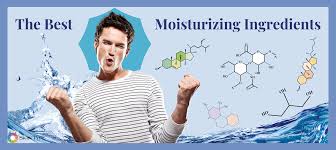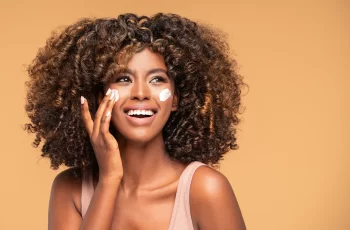
Hydrating and Moisturizing Ingredients List and Dictionary
There are several categories of hydrating and moisturizing ingredients found in moisturizers. There is not one best moisturizing ingredient in face and body creams. The best moisturizers have a combination of several types of moisturizing ingredients.
Different types of moisturizers contain various combinations of ingredients from these categories. The best moisturizing ingredients for you depends upon your Baumann Skin Type, so take the skin type quiz before buying any moisturizers so you know what ingredients to look for on the products moisturizing ingredients list.
There are 5 main categories of moisturizing ingredients. The best moisturizers include a combination of ingredients from different categories.
Glycerin and hyaluronic acid are best at hydrating your skin quickly, but results are short-term.
For longer-term results, you need moisturizing ingredients that will repair the skin barrier.
The best moisturizing ingredients for you depend on your Baumann Skin Type. Take the quiz for personalized recommendations.
List of Moisturizing Ingredient Categories
These are the five main categories of moisturizing ingredients:
Emollients
Humectants
Occlusives
Oils
Fatty acids
emollient ingredients
Emollient Moisturizing Ingredients
Emollient moisturizing ingredients coat the skin’s surface. This has several benefits:
Smooth skin
Make skin radiant
Allow skin to reflect light
Coat and hide fine lines and wrinkles
Think of emollients as a Snap Chat filter for your skin- making it look better temporarily.
Emollients can have a dual function and also be humectants and occlusives.
What are humectants
Humectant Moisturizing Ingredients
Humectant moisturizers pull water into themselves. If you are in a humid climate this will have several effects:
The area will swell
Fine lines will improve
Skin will get a dewy appearance
Shiny glass- like skin may result
In a dry climate, humectants can pull water from skin and dehydrate it. Combining the moisturizer with occlusive moisturizing ingredients will solve this issue.
occlusive moisturizing ingredients
Occlusive Moisturizing Ingredients
Occlusive moisturizing ingredients form a protective layer on the skin’s surface. These are usually made of:
Oils
Fats
Fatty acids
Fatty alcohols
Butters
Wax
Petrolatum
Silicone pads, plastic wrap and wound dressings can also provide occlusion and skin protection. Essential oils are not considered occlusives.
Natural Moisturizing Factor
Natural Moisturizing Factor (NMF) is a crucial element that regulates the hydration of our skin by providing moisturizing ingredients inside skin cells.
NMF is made up of a mixture of low molecular weight and water-soluble substances derived from a protein called filaggrin, which is found inside our keratinocyte skin cells. Filaggrin plays an interesting role in maintaining the skin’s barrier function and hydration. In the lower layers of the skin, it serves a structural purpose, but as it moves higher up, it breaks down into amino acids and is known as NMF.
Natural Moisturizing factor is made up of these amino acids:
Histidine
Glutamine
Arginine
All of these amino acids have hygroscopic properties, meaning they attract and bind water effectively. (They are humectants.) Through specific chemical transformations, these amino acids give rise to compounds such as trans-urocanic acid, pyrrolidone carboxylic acid, and citrulline, which collectively form the NMF.
Can Natural Moisturizing Factor Be in Skin Care Products?
Despite efforts by researchers, it has been challenging to replicate the exact composition of the NMF found naturally in our skin. The NMF’s unique ability to adapt to different environments and its individual variation among people make it difficult to replicate in a skincare product. Nevertheless, the amino acids from which it is derived continue to be used in moisturizers to provide effective hydration for the skin.
While the NMF itself is not found in most moisturizing skin care products, the amino acids derived from filaggrin, such as histidine, glutamine, and arginine, are commonly used ingredients. These amino acids act as humectants, helping the skin retain moisture and remain hydrated.
How to Find NMF on Product Labels
NMF itself is not found in products, but the components it is made of can be. Look for these moisturizing ingredients on product labels:
Pyrrolidone carboxylic acid (PCA)
Urea
Lactate
Histidine
Glutamine
Arginine
The best moisturizing ingredients
What Is the Best Moisturizing Ingredient?
Glycerin is the best moisturizing ingredient to moisturize the skin quickly. Hyaluronic acid is the second best to give fast but temporary results. These are both humectant ingredients. They do not repair the skin barrier and they do not give long-term results. Results may only last one day.
What Is the Most Hydrating Ingredient for the Skin?
Water is the most hydrating ingredient for skin. However, water tends to evaporate off of the skin, so it needs to be combined with humectants to hold it on the skin’s surface, and occlusives to keep it from evaporating away.
Oils are also wonderful hydrating ingredients for the skin. Some oils hydrate better than others. However, using too many occlusive ingredients such as oils and petrolatum can clog pores. Beware of moisturizing ingredients that are comedogenic if you have acne-prone skin.
oils as moisturizing ingredients
Natural Moisturizing Ingredients
Many moisturizers like propylene glycol are chemicals made in the lab. But there are many good natural hydrating ingredient options. The fastest way to hydrate skin naturally is with glycerin, but oils are a natural way to deliver hydrating fatty acids to the skin.
Which natural moisturizing ingredients are best depends upon your skin type. Some skin types need saturated fatty acids, while others need unsaturated fatty acids. Some skin types will prefer light humectant moisturizers, while very dry skin types will prefer greasy oils.
When looking for the best natural oils in moisturizers, remember that essential oils are not good moisturizing ingredients.
What Is an Example of a Moisturizing Ingredient?
Ingredients that you can look for on a skin care product label that are moisturizing include:
Argan oil
Cocoa butter
Evening primrose oil
Glycerin
Glyceryl stearate
Grape seed oil
Hyaluronic acid
Macadamia oil
Shea butter
Squalane
Sunflower oil
There are many more moisturizing ingredients. Learn how to find the best moisturizer for your skin here.
Take the quiz and we will give you examples of skin care brands with the best moisturizing ingredients.


